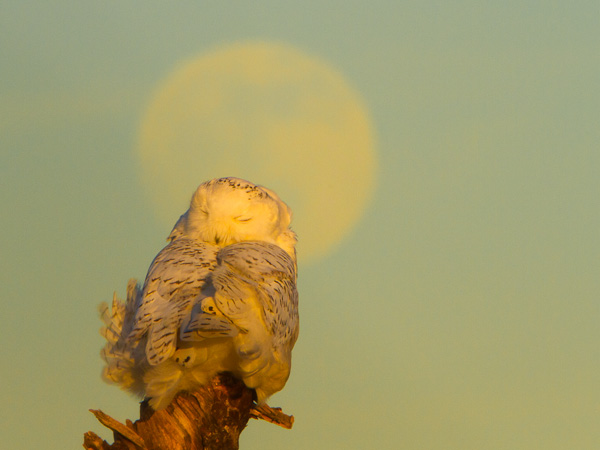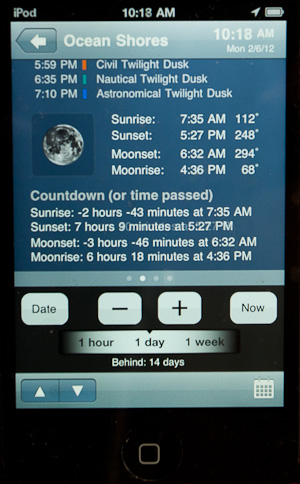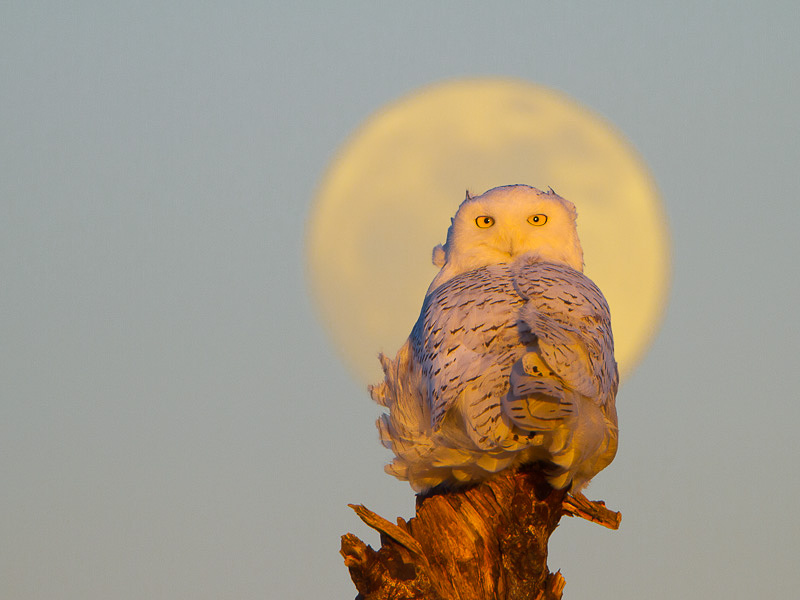The Photographers’s Ephemeris (TPE), moon and sun locations and more . . .

Back in January I was very much impressed by a Lee Rentz photo of a perched Snowy Owl backed by a round red moon. Of many Snowy Owl images from this irruption year, this one struck me as unique. It also struck me as a doable shot without harassing the owls.
In capturing the image, Lee took advantage of a fleeting opportunity. Red moons are only red if very low on the horizon, unless maybe a forest fire or heavy pollution is at hand. The horizon is indeed low to the east at Damon Point in Ocean Shores, where Lee got the shot. It’s also an almost unheard of prospect in western Washington, as we get blocked by the Cascade Range that adds altitude before the moon shows—that is if it shows at all here in rain country.
Getting a shot like this depends on a bit of luck with the weather, and, of course, timing. I decided to pursue a similar shot, and I wanted a sunlit owl with my full moon. Drawing on experience, I knew the best date for that would be the day before a full moon. On that date the moon looks full to our eye, but the sun hasn’t yet set (The other day that would work is the day after the full moon—but at sunrise instead of sunset). The vision of warm evening light on a Snowy Owl against a backdrop of a golden moon drove a calendar check to set the shoot date at February 6th.

If this were the 90’s, that’s all the information I would have (or need). I’d head out on the 6th and hope the forecast brought a sunny day and a visible moonrise. One more bit of knowledge: When the moon is full, it rises opposite the setting sun. In Washington State, in early February, the sun sets in the southwest; I could expect the moonrise in the northeast.
Tools online
We’re no longer in the 90’s, of course, and today online tools and phone apps aid photography in remarkable ways. One website worth a look is www.timeanddate.com, where sunrise, sunset, moonrise and moonset, time and direction can be found for any date. It’s easy to use and understand, but you have to look up the sun and moon info separately, and you can’t plug in exact latitude and longitude, but instead need to rely on a (worldwide) cities list.
Another tool is the US Navy : http://www.usno.navy.mil/USNO/astronomical-applications/data-services. This is easy to use for USA locations; not so much worldwide. It gives rise and set times on one webpage and a table form of azimuth (direction from North) and altitude on another. US Navy was a good place to go, but, given newer apps (below), there’s little reason to go there.
Handier is the app VelaClock for iPhone or iPod ($4). It doesn’t require an internet connection, yet it calculates sun and moon rise and set times as well as azimuth in a simple display that’s very useful in the field. I dialed in the February 6, 2012 date on my iPod and VelaClock spit back just what I needed: moonrise, 4:36pm, azimuth, 68°; sunset, 5:27pm, azimuth, 248°.
Holy Grail: The Photographer’s Ephemeris
The current Holy Grail for figuring sun/moon info and more is The Photographer’s Ephemeris (TPE). It can be purchased as an app for iPhone or Android, but it’s a free download for your internet-connected desktop. TPE makes use of Google maps, and what you can pull out of it is astounding.

I used the Google maps panel in the TPE window to quickly find Damon Point at Ocean Shores. Then I opened the calendar, clicked on the February 6th, 2012, date, and read moonrise and azimuth data that matched what I found on VelaClock.
A click on the Details button brought up additional useful information. I used a second (gray) maker to roam the Google terrain hills to the east, and found that the elevations (actually the altitude angle) above the horizon were quite small. The hills behind Grays Harbor stick up only about .3°. Some of the distant Cascade peaks are a higher angle (loftly Mt. Rainier, about 112 miles away, is .7°), but not much. The chance for a red moon at moonrise was good.
On February 6th, we drove to Ocean Shores and slogged to Damon Point. We discovered a Snowy Owl on a good perch in the late afternoon, and, as luck would have it, he (probably a first-year male) moved to an even better perch just before moonrise. I was lined up, stoked and ready, but the moon failed to appear for a time due to moisture in the sky, and when it did show it was very faint. There would be no red moonrise. Nonetheless, I adjusted my tripod lower and lower trying to capture the owl with moon as the moon climbed into the sky. When the moon brightened, finally, to a pleasing yellow-white glow, it was too high in the sky to capture together with the bird. I took an out-of-focus moon shot to later combine in Photoshop.

The next day in the office, I opened a Snowy select and the out-of-focus moon in Elements 10. Combining them was routine, involving selecting the sky in the Snowy Owl image, and replacing it with the OOF moon that I moved into place on a separate layer. I would much prefer a single-image capture in the field—instead of a digital composite—but the composite did allow the freedom of a moon precisely-positioned, a bit bigger and a little more in focus compared to a single, in-camera capture. I might even be able to sell it.
Gary